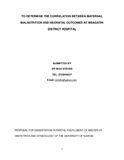| dc.description.abstract | Background
The nutritional status of a woman before, during pregnancy and after delivery is critical to both her infant's and her own health and survival. Maternal malnutrition and suboptimal weight gain during pregnancy are risk factors for LBW. Neonatal mortality rates are two to three times higher for LBW babies.
Obesity is a worldwide epidemic. Related complications range from infertility, hypertensive disorders, coagulopathies, gestational diabetes, and fetal complications such as LGA, congenital malformations, stillbirth, and shoulder dystocia
Objective: To determine the prevalence of maternal malnutrition and compare neonatal outcomes of underweight, normal weight, overweight and obese mothers.
Study design: This was a cross-sectional study of normal newborn babies delivered at Mbagathi district hospital and their mothers to determine the prevalence of malnutrition and compare the neonatal outcomes of underweight, normal weight, overweight and obese mothers.
Study area: Mbagathi District Hospital, Nairobi, Kenya
Study population: The target population was all women delivering normal singletons and neonates born during the study period.
Methodology: All women delivering normal singletons and neonates born in the study period were recruited sequentially till the sample size of 372 pregnant women was achieved. The measurements taken from the mothers who consented are body weight to the nearest 0.1 kg and body height to the nearest 0.1 cm. The BMI of the mothers was calculated by dividing the weight (Kg) by the square of the height (cm). BMI 12
Categories: underweight = <18.5 Normal weight = 18.5-24.9 Overweight = 25-29.9 Obesity = BMI of 30 or greater.
The neonates in the study were measured after 6 hours to allow for birth edema to subside and not more than 24 hours after delivery. The following measurements were taken: body weight to the nearest 10 g; recumbent length (crown heel length) to the nearest 0.1 cm.
Data Management and Analysis Statistical package SPSS version 17 was employed in Data analysis.
Results: The mean age of the study participants was 24.9 years (SD 5). The mean BMI was 24.2 (SD 3.7). The prevalence of maternal malnutrition was 38.1%. The mothers with obesity were found to be significantly older with mean age 28.4 (SD 5.0).
The mean weight of the neonates was 3.1 (SD 0.5), while the mean length 47.9 (SD 5.2). The mean birth weight increased from the underweight BMI 2.8 (SD 0.3), normal BMI 3.0 (SD 0.5) and overweight group 3.2 (SD 0.5). The overweight group was comparable to babies born to obese mothers mean weight 3.1 (SD 0.3).
The mean length showed no significance in the four BMI categories.
Conclusion: This study showed that mothers with obesity were significantly older.
The study showed an increase in BMI with increased parity of two or more children.
The study found that there was an increase in birth weight with increase of maternal BMI.
Recommendation: Improving maternal nutrition and encouraging antenatal services facilitating nutrition and care during pregnancy can lead to improved perinatal outcomes in our population. | en_US |
| dc.description.department | a
Department of Psychiatry, University of Nairobi, ; bDepartment of Mental Health, School of Medicine,
Moi University, Eldoret, Kenya | |

